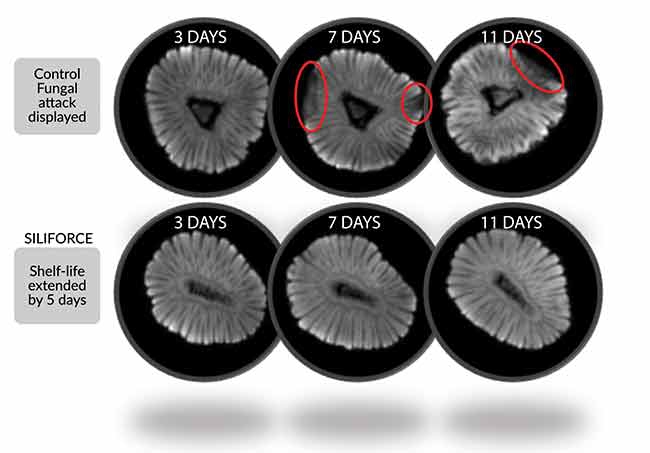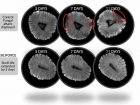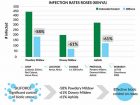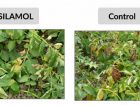
Features
Fertilizer
Inputs
Silicon is often a forgotten element in plant nutrition
Although vital to plant health, silicon is not considered an essential plant element here in North America. This has led some growers to believe it is not necessary to add it to their nutrition regimen.
September 14, 2016 By Frank Houben
 Effect on Shelf-life (MRI) Strawberry & Grape
Effect on Shelf-life (MRI) Strawberry & Grape October 2016 – Silicon (Si) is the second most abundant element in the Earth’s crust next to oxygen . It is a major component of plant tissue. It is found in varying concentrations in virtually all living tissue, plants, animals and humans.
Though there has been research into the role silicon plays in biology, scientists are really just cracking the code of this often ignored plant nutrient.
Although vital to plant health, silicon is not considered an essential plant element here in North America. This has led some growers to believe it is not necessary to add it to their nutrition regimen.
Technically, a plant can grow without silicon but there is a significant gap between survival and optimal health. It is clear that optimal plant health requires a constant supply of plant-available silicon. Now with new instrumentation and ambition to solve the world’s food crisis, silicon is surging to the forefront of plant science research.
BENEFICIAL IN VARIOUS WAYS
Silicon is beneficial to plant health, yield and crop quality in various ways. One of the best-known effects is the strengthening of the cell walls, which helps the plant build strong branches and stems that can uptake and transport more water and nutrients.
Silicon forms a protective coating on an intracellular level that decreases transpiration and enables plants to continue functioning during high-temperature or low-moisture conditions. As a resistance measure, the plant uses the silicon to build up an additional mineral barrier making it more difficult for diseases, pathogens and insects to penetrate the cell walls.
Silicon also plays an important role in enhancing the uptake of nutrients, reducing antagonistic action between elements and increasing the plant’s natural resistance to pests, diseases and climate stress.
Enhanced metabolic functions are observed when plants are grown with the use of soluble silicon; they show higher concentrations of chlorophyll in their leaf tissue compared to plants grown without it. Silicon also enables plants to make more efficient use of CO2.
USED THROUGHOUT THE ENTIRE LIFE CYCLE OF THE PLANT
Studies show that silicon should be used throughout the entire life cycle of the plant, from the seedling or clone stage up until harvest.
In order to produce optimal results, silicon needs to be continually made available to the plant. Once a plant has absorbed the available silicon into its cellular structure, it can no longer be redistributed to other parts of the plant.
The common form of silicon found in the soil is silicon dioxide. It needs to be converted by microbes (and possibly natural chemical reactions) into mono-silicic acid, before it can be taken up by the plant’s root system. This process is complex and can take time to occur in meaningful amounts. Mono-silicic acid is the only plant available form of silicon.
The most efficient way to apply silicon to plants is the use of mono-silicic acid by foliar spray. Plants can absorb much more through foliar feeding than just absorption through the root zone.
New research shows that mono-silicic acid has a profound effect on the transport and utilization of nutrients and also plays a role in enhancing the plant’s natural defence systems. As a monomer (single molecule) silicic acid is easily absorbed by the roots or leaves and quickly transported throughout the plant via the xylem.
During transport through the xylem, most of the monomeric silicic acid is polymerized and then deposited in the outer cuticle of the cell wall. This layer of silicon forms a rigid structure on the outside of the cell, which is responsible for the many commonly known structural and pest resistant benefits of silicon.
Smaller amounts of mono-silicic acid remain un-polymerized and help increase the sap pressure within the xylem, optimize the transport of nutrients and increase brix and mineral content.
SPECIFIC FORMULAS
Today, specific formulas of stabilized mono-silicic acid that can be applied to plants are available on the market (commercial names – SILAMOL, SILIFORCE). The new generation of mono-silicic acid-based products show low silicon content (one to three per cent) but in a plant available form. More and more growers and farmers see the benefits of applying these formulas in vegetable crops like cucumbers, tomatoes, peppers and potatoes. Fruit farmers growing strawberries, blueberries, apples, peaches, nectarines and grapes also see the benefits.
In today’s agriculture the (over) application of pesticides, fungicides and herbicides have become a real concern – plants are weak and weak plants attract opportunistic pests and diseases. Many growers are now looking for a more sustainable and preventive approach to these challenges by building up the plant’s natural defence systems against abiotic and biotic stress.
Mono-silicic acid continues to prove itself as a powerful tool in the grower’s toolbox for creating healthier plants that naturally resist many problems.
Frank Houben is the silicon (Si) technical specialist with Agro-Solutions B.V., info@ibeco.nl.
Print this page


